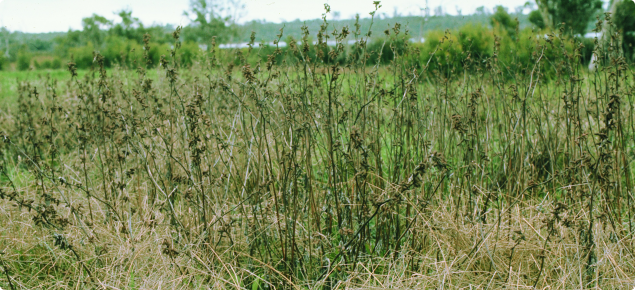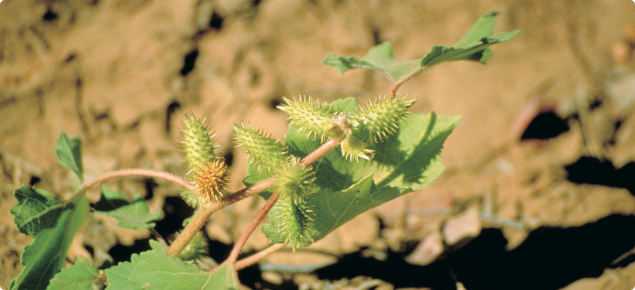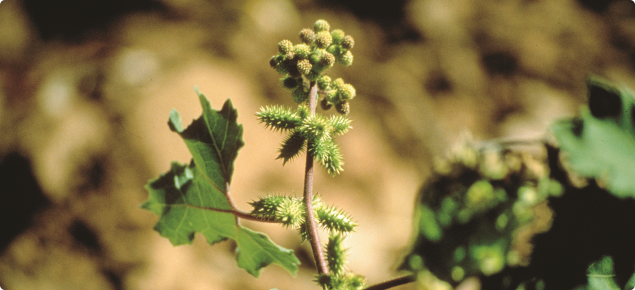Introduction
Noogoora burr is one of the most serious and widespread weeds in the world. It is mainly found in areas with high rainfall and a temperate climate but it may also persist in arid environments, where the seeds may remain dormant for years and then take advantage of occasional rainfall to reproduce.
The Western Australian Organism List (WAOL) contains information on the area(s) in which this pest is declared and the control and keeping categories to which it has been assigned in Western Australia (WA). Use the external links on this page to reach Noogoora burr in WAOL.
Four closely related species (Noogoora, Hunter, South American and Californian burr) are generally referred to as Noogoora burr. They each differ in the size of the burr, the shape of the two terminal spines on each burr and the leaf shape. Bathurst burr (Xanthium spinosum) is a related weed.
Noogoora burr is a native of the south of North America, Mexico and the Caribbean. It was first noticed in Australia on Noogoora Station, Queensland in the 1870s, where it was probably introduced as a contaminant of cotton seeds. It has since spread over much of Queensland and New South Wales. Other infestations occur in Victoria, South Australia, the Northern Territory and certain sections of the Kimberley in WA. The total infested area in Australia exceeds two million hectares.
Why Noogoora burr matters to you
Noogoora burr is often abundant after spring or summer floods in the far north. It can be found along river and creek flats, on roadsides and in pasture land. Noogoora burr spreads by seed located in the burrs. Burrs are spread by attaching to animals, clothing and bags. Burrs can also float on water.
Noogoora burr is poisonous to stock at the seedling stage. Due to the hooked spines on the burr which tangle in wool it impacts on production costs. Burr infested wool fetches less at auction due to the high processing cost of burr removal. The dry burrs may also cause discomfort and injury, particularly to sheep. The weed’s growth is sometimes so dense along riverbanks that cattle and sheep cannot get to watering places.
It is a major weed of irrigated soya beans, maize, sunflowers and cotton. Noogoora burr reduces production in crops and pasture by competing for moisture, nutrients and light.
What to look for
Noogoora burr stems normally grow up to 2.5 m in height but occasionally reach 4 m. Isolated plants have a branched stem, but plants growing in a clump are usually single stemmed. The stems lack spines, unlike Bathurst burr, but have a fine bristly covering. Stems are often arranged in a zigzag manner and usually carry purplish blotches or streaks in young plants.
Noogoora burr has a deep taproot and an extensive root system. The leaves are similar in shape to a grapevine leaf with prominent veins. They have minute bristles on both surfaces and jagged edges. The upper surface of the leaf is dark green while the under surface is pale green.
The flowers are green and inconspicuous. Male flowers form in clusters at the ends of branches, but soon drop off. Female flowers form on short stalks at the base of the leaf and at the ends of the main stem and side branches. The female flowers develop into green burrs that turn brown when ripe. The ripe burr is an elongated egg shape. It is woody, 10 to 20mm long and 4 to 8mm wide. The burr is densely covered with hooked spines and has large hornlike projections at the tip. Two seeds are produced in each burr. They are brown, 4 to 8mm long and flattened on one side.
Life history of Noogoora burr
Noogoora burr is a summer growing annual plant. Germination usually occurs between August and December in temperate climates but can occur at any time of year under favourable conditions.
In the Kimberley germination occurs in the wet season, from December to March and the plant flowers from April to May. Ripe burrs begin to appear in June and continue until the plants die off, usually due to lack of moisture.
What you can do about Noogoora burr
Practice good biosecurity to keep Noogoora burr and other weeds off your property. Take particular care when purchasing fodder to avoid buying anything contaminated with weed seeds or toxic plants. Ensure contractors entering your property have clean equipment to avoid the introduction of new weeds.
It is an offence under WA legislation to sell or transport produce or other material contaminated with declared plants.
Prompt action is necessary to eradicate new and/or isolated patches of Noogoora burr and to prevent the weed becoming established in new areas.
Report suspected Noogoora burr, offences regarding declared plants or any other unusual weeds as soon as possible. Reports can be made to the Department of Primary Industries and Regional Development through the Pest and Disease Information Service on Freecall 1800 084 881.
Further information
For further information on Noogoora burr, look at the following webpages
- Noogoora burr: declared pest: for damage done, reporting and requirements
- Noogoora burr control: for control
- Noogoora burr factsheet
- or contact the Pest and Disease Information Service (PaDIS)
The book Noxious Weeds of Australia, by W.T. Parsons and E.G. Cuthbertson (2001, CSIRO Publishing) has detailed information about all species that are declared plants or noxious weeds in every State.
A useful source of weed information is the Weeds Australia webpage weeds.org.au.




